 W
WAmerica 500 Years is the title of a series of paintings created in 1988–91 by Nabil Kanso in commemoration of the 500th anniversary of the discovery of America. The works in the series base their subjects on historical events in the Americas over the course of five centuries.
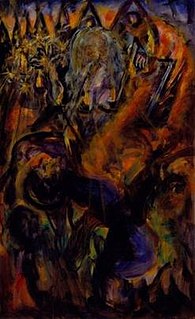 W
WThe Apocalypse Series encompasses 125 works consisting of 75 paintings and 50 drawings created between 1982 and 1984 by Nabil Kanso. The subjects of the works in the series are based on the Revelation of Saint John the Evangelist. The colors of this painting are somber, suggesting richness and heaviness, while the repetitive geometry of the shapes suggest apocalyptic inevitability. In Peran Erminy's article, The Apocalyptic Paintings of Nabil Kanso, he clearly states that Kanso's paintings portray our world today. He states that our world is constantly surrounded by violence and people feel vulnerable. The aggression one has can ultimately lead to a break out in war where the world will be doomed. Kanso's paintings reflect the path we are taking as a world. People today are quick to act upon threats leading us into a world that is ruled by war. This will be the hell on earth made by none other than human beings themselves. Kanso has a strong, intense effect on his audience's feelings and emotions. Kanso's work is dark and sometimes frightening, conveying how it is relevant to the scary obstacles of today's world. Our society seems to be stuck on depressing violence and aggression and if continued on this path, will only continue to result in tragic wars.
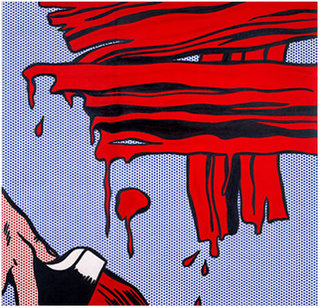 W
WBrushstrokes series is the name for a series of paintings produced in 1965–66 by Roy Lichtenstein. It also refers to derivative sculptural representations of these paintings that were first made in the 1980s. In the series, the theme is art as a subject, but rather than reproduce masterpieces as he had starting in 1962, Lichtenstein depicted the gestural expressions of the painting brushstroke itself. The works in this series are linked to those produced by artists who use the gestural painting style of abstract expressionism made famous by Jackson Pollock, but differ from them due to their mechanically produced appearance. The series is considered a satire or parody of gestural painting by both Lichtenstein and his critics. After 1966, Lichtenstein incorporated this series into later motifs and themes of his work.
 W
WCampbell's Soup Cans is a work of art produced between November 1961 and March or April 1962 by American artist Andy Warhol. It consists of thirty-two canvases, each measuring 20 inches (51 cm) in height × 16 inches (41 cm) in width and each consisting of a painting of a Campbell's Soup can—one of each of the canned soup varieties the company offered at the time. The non-painterly works were produced by a screen printing process and depict imagery deriving from popular culture and belong to the pop art movement.
 W
WThe Canto Collection is a series of 124 equally sized paintings made by the painter Rob Møhlmann. He worked on the series from 1982 up to and including 1993. Each painting depicts, as its central topic, literally and figuratively, an everyday tin can of the non-existent brand, Canto. The Canto Collection has been on permanent display, since 2008, in Museum Møhlmann, Appingedam, the Netherlands.
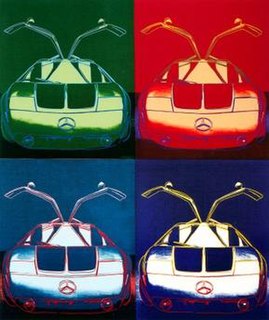 W
WCars is a series of artworks by the American artist Andy Warhol, commissioned by Mercedes-Benz in 1986.
 W
WThe Cluster Paintings are a series of paintings created by Nabil Kanso in 1986-1988. They are characterized by compositions that divide the canvas space into sections reflecting a cluster of irregular shaped planes offering variations of contrasts and viewpoints. These characteristics expanded in later works such as the America and Living Memories series.
 W
WThe Columbus murals are a series of twelve murals depicting Christopher Columbus, painted in the 1880s by Luigi Gregori and displayed in the Main Building at the University of Notre Dame in Indiana, US. The murals have been a source of controversy in recent decades for their romanticized portrayal of Columbus and his relationship with Native Americans.
 W
WThe Course of Empire is a series of five paintings created by Thomas Cole in the years 1833–1836. It is notable in part for reflecting popular American sentiments of the times, when many saw pastoralism as the ideal phase of human civilization, fearing that empire would lead to gluttony and inevitable decay. The theme of cycles is one that Cole returned to frequently, such as in his The Voyage of Life series. The Course of Empire comprises the following works: The Course of Empire – The Savage State; The Arcadian or Pastoral State; The Consummation of Empire; Destruction; and Desolation. All the paintings are oil on canvas, and all are 39.5 inches by 63.5 inches except The Consummation of Empire which is 51″ by 76″.
 W
WThe Dance of Salomé is the title of a series of 160 works consisting of 85 paintings and 75 drawings created by Nabil Kanso in 1988 and 1995. It is based on biblical and literary works with particular reference to Oscar Wilde’s 1891 play and Richard Strauss’s 1905 opera. The primary subject of all the works in the series is Salomé who is depicted in a sequence of scenes reflecting various nuances of perception in distinctive dance movement.
 W
WDogs Playing Poker, by Cassius Marcellus Coolidge, refers collectively to an 1894 painting, a 1903 series of sixteen oil paintings commissioned by Brown & Bigelow to advertise cigars, and a 1910 painting. All eighteen paintings in the overall series feature anthropomorphized dogs, but the eleven in which dogs are seated around a card table have become well known in the United States as examples of kitsch art in home decoration.
 W
WDreamvision (paintings) is a series of 28 oil paintings made by Nabil Kanso in 1980-81. The subjects of the works in the series are two figures of a man and woman whose characters and relations are reinforced by figurative allusions to their surroundings.
 W
WThe Eiffel Tower series of Robert Delaunay is a cycle of paintings and drawings of the Eiffel Tower. Its main sequence was created between 1909 and 1912, with additional works added up to 1928. The series is considered the most prominent art depicting the iconic Paris tower as well as the most prominent work of Delaunay.
 W
WFaust is a series of approximately 100 paintings created between 1976 and 1979 by Nabil Kanso. The paintings depict figural compositions in a sequence of scenes whose subjects are loosely based on Goethe’s 1808 play Faust Part One and Part Two.
 W
WThe Femme Maison (1946–47) series of paintings by French American artist Louise Bourgeois address the question of female identity. In these paintings, the heads and bodies of nude female figures have been replaced by architectural forms such as buildings and houses. Femme Maison translates from the French as ‘housewife’: literally, ‘woman house’. In 1984 Bourgeois produced a small series of Femme Maison prints based on the works of 1947.
 W
WLes Femmes d'Alger is a series of 15 paintings and numerous drawings by the Spanish artist Pablo Picasso. The series, created in 1954–1955, was inspired by Eugène Delacroix's 1834 painting The Women of Algiers in their Apartment. The series is one of several painted by Picasso in tribute to artists that he admired.
 W
WThe Flower Book by Edward Burne-Jones (1833–1898) is a series of 38 round watercolours, each about six inches across, painted from 1882 to 1898. The paintings do not depict flowers; rather, they were inspired by the flowers' names. Burne-Jones called them "a series of illustrations to the Names of Flowers". "Not a single flower itself appears", according to his wife Georgiana. They were painted for his private pleasure, many while he was resting at his summer home in Rottingdean, and were described by his wife as the "most soothing piece of work that he ever did". In 1905 Georgiana, by then a widow, published a limited edition of high-quality colour facsimiles.
 W
WThe Four Freedoms is a series of four 1943 oil paintings by the American artist Norman Rockwell. The paintings—Freedom of Speech, Freedom of Worship, Freedom from Want, and Freedom from Fear—are each approximately 45.75 inches (116.2 cm) × 35.5 inches (90 cm), and are now in the Norman Rockwell Museum in Stockbridge, Massachusetts. The four freedoms refer to President Franklin D. Roosevelt's January 1941 Four Freedoms State of the Union address in which he identified essential human rights that should be universally protected. The theme was incorporated into the Atlantic Charter, and became part of the charter of the United Nations. The paintings were reproduced in The Saturday Evening Post over four consecutive weeks in 1943, alongside essays by prominent thinkers of the day. They became the highlight of a touring exhibition sponsored by The Post and the U.S. Department of the Treasury. The exhibition and accompanying sales drives of war bonds raised over $132 million.
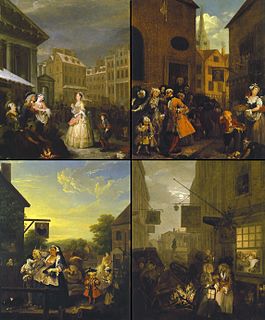 W
WFour Times of the Day is a series of four oil paintings by English artist William Hogarth. They were completed in 1736 and in 1738 were reproduced and published as a series of four engravings. They are humorous depictions of life in the streets of London, the vagaries of fashion, and the interactions between the rich and poor. Unlike many of Hogarth's other series, such as A Harlot's Progress, A Rake's Progress, Industry and Idleness, and The Four Stages of Cruelty, it does not depict the story of an individual, but instead focuses on the society of the city in a humorous manner. Hogarth does not offer a judgment on whether the rich or poor are more deserving of the viewer's sympathies. In each scene, while the upper and middle classes tend to provide the focus, there are fewer moral comparisons than seen in some of his other works. Their dimensions are about 74 cm (29 in) by 61 cm (24 in) each.
 W
WFour Times of the Day is a series of four paintings depicting four times of the day: Morning, Midday, Evening, and Night by the French landscape painter Claude Joseph Vernet (1714–1789).
 W
WWillie Gillis, Jr. is a fictional character created by Norman Rockwell for a series of World War II paintings that appeared on the covers of 11 issues of The Saturday Evening Post between 1941 and 1946. Gillis was an everyman with the rank of private whose career was tracked on the cover of the Post from induction through discharge without being depicted in battle. He and his girlfriend were modeled by two of Rockwell's acquaintances.
 W
WThe Great Red Dragon paintings is a series of watercolour paintings by the English poet and painter William Blake, painted between 1805 and 1810. It was during this period that Blake was commissioned to create over a hundred paintings intended to illustrate books of the Bible. These paintings depict "The Great Red Dragon" in various scenes from the Book of Revelation.And behold a great red dragon, having seven heads and ten horns, and seven crowns upon his heads. And his tail drew the third part of the stars of heaven, and did cast them to the earth.
 W
WJacob and his twelve sons is a series of thirteen paintings by Spanish artist Francisco de Zurbarán.
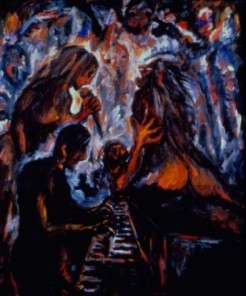 W
WJazz is a series of 20 paintings made by Nabil Kanso in 1978-79. The subjects of the works are based on the jazz music and the entertainments night life in New York and New Orleans. The paintings are done in oil and acrylic on canvas measuring 224 X 182 cm each. Their compositions reflect predominant red tonality built with broad brushstrokes. Works from the series were exhibited in Atlanta in 1985.
 W
WThe Last Judgement is a triptych of oil paintings by the British artist John Martin, created in 1851–1853. The work comprises three separate paintings on a theme of the end of the world, inspired by the Book of Revelation. The paintings, The Plains of Heaven, The Last Judgement, and The Great Day of His Wrath, are generally considered to be among Martin's most important works, and have been described by some art critics as his masterpiece.
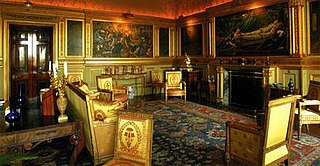 W
WThe Legend of Briar Rose is the title of a series of paintings by the Pre-Raphaelite artist Edward Burne-Jones which were completed between 1885 and 1890. The four original paintings – The Briar Wood, The Council Chamber, The Garden Court and The Rose Bower – and an additional ten adjoining panels, are located at Buscot Park in Oxfordshire, England.
 W
WLiving Memory is the title of a series of 9 mural-size paintings on the Holocaust painted by Nabil Kanso in 1980, 1990 and 1993-94.
 W
WThe Marie de' Medici Cycle is a series of twenty-four paintings by Peter Paul Rubens commissioned by Marie de' Medici, widow of Henry IV of France, for the Luxembourg Palace in Paris. Rubens received the commission in the autumn of 1621. After negotiating the terms of the contract in early 1622, the project was to be completed within two years, coinciding with the marriage of Marie's daughter, Henrietta Maria. Twenty-one of the paintings depict Marie's own struggles and triumphs in life. The remaining three are portraits of herself and her parents. The paintings now hang in the Louvre in Paris.
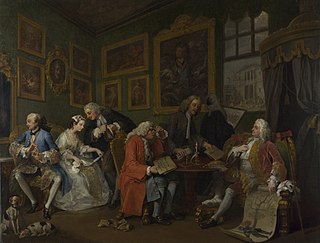 W
WMarriage A-la-Mode is a series of six pictures painted by William Hogarth between 1743 and 1745, intended as a pointed skewering of 18th-century society. They show the disastrous results of an ill-considered marriage for money or social status, and satirises patronage and aesthetics. The pictures are held in the National Gallery in London.
 W
WOthello is a series of paintings executed in 1985 by Nabil Kanso. The subjects of the paintings are loosely based on Shakespeare’s tragedy Othello. The series comprises 60 paintings dealing with themes of love, race, jealousy, betrayal, and evil. They depict scenes embodying compositions of figural and metaphorical imagery that may be seen as visually reflecting the intimate and dramatic relationship between Othello and Desdemona, and the tense and uneasy relation that passes between and through Othello, Desdemona and Iago.
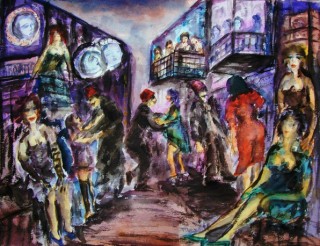 W
WPlace des Martyres is the title of a series of over 250 watercolors and drawings executed in New York and Beirut between 1971 and 1974 by Nabil Kanso. The subjects of the works in the series are based on the women headquartered in the red-light district of Beirut city center called el Bourj, and after World War I named Place des Martyrs French for Martyrs’ Place in memory of dozens of Arab nationalists who were hanged in 1915-16 during Ottoman rule.
 W
WPygmalion and the Image is the second series of four oil paintings in the Pygmalion and Galatea series by the Pre-Raphaelite artist Edward Burne-Jones which was completed between 1875 and 1878. The two collections may be seen below, in the Gallery, the first being now owned by Lord Lloyd Webber, and the second housed at the Birmingham Museum & Art Gallery. This article deals with an appraisal of the second series.
 W
WThe Raven is a series of 28 watercolor paintings made by Nabil Kanso in 1995. The subjects of the works in the series are based on the 1845 poem "The Raven" by Edgar Allan Poe.
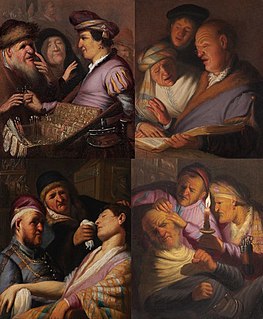 W
WThe Senses is a series of five oil paintings, completed c. 1624 or 1625 by Rembrandt, depicting the five senses. The whereabouts of one, representing the sense of taste, is unknown. Another, representing smell, was only re-identified in 2015.
 W
WThe Shot Marilyns is a work of art produced in 1964 by Andy Warhol. It consists of four canvases, each a square measuring 40 inches and each consisting of a painting of Marilyn Monroe, each shot through in the forehead by a single bullet.
 W
WThe Sick Child is the title given to a group of six paintings and a number of lithographs, drypoints and etchings completed by the Norwegian artist Edvard Munch between 1885 and 1926. All record a moment before the death of his older sister Johanne Sophie (1862–1877) from tuberculosis at 15. Munch returned to this deeply traumatic event repeatedly in his art, over six completed oil paintings and many studies in various media, over a period of more than 40 years. In the works, Sophie is typically shown on her deathbed accompanied by a dark-haired, grieving woman assumed to be her aunt Karen; the studies often show her in a cropped head shot. In all the painted versions Sophie is sitting in a chair, obviously suffering from pain, propped by a large white pillow, looking towards an ominous curtain likely intended as a symbol of death. She is shown with a haunted expression, clutching hands with a grief-stricken older woman who seems to want to comfort her but whose head is bowed as if she cannot bear to look the younger girl in the eye.
 W
WThe Slav Epic is a cycle of 20 large canvases painted by Czech Art Nouveau painter Alphonse Mucha between 1910 and 1928. The cycle depicts the mythology and history of Czechs and other Slavic peoples. In 1928, after finishing his monumental work, Mucha bestowed the cycle upon the city of Prague on condition that the city build a special pavilion for it. Prior to 2012, the work was a part of the permanent exhibition at the chateau in the town of Moravský Krumlov in the South Moravian Region of the Czech Republic. In 2012, all 20 works were moved and displayed together on the ground floor of the Veletržní Palace till 2016, in an exhibition organized by the National Gallery in Prague. The works are currently not on display, waiting for a new location to be completed in Prague.
 W
WThe Split of Life is a series of over 80 mural size oil paintings by Nabil Kanso. The paintings span a period from 1974 to 1994, and deal with contemporary and historical issues of war and violence.
 W
WTwo Men Contemplating the Moon and Man and Woman Contemplating the Moon are a series of similar paintings by Caspar David Friedrich, the setting being among his best-known works. Friedrich painted at least three versions, with one variation featuring a man and a woman. The 1819–20 version in the Galerie Neue Meister is thought to be the original; the c. 1824 variant with a woman is in the Alte Nationalgalerie; and the c. 1830 version is in the Metropolitan Museum of Art.
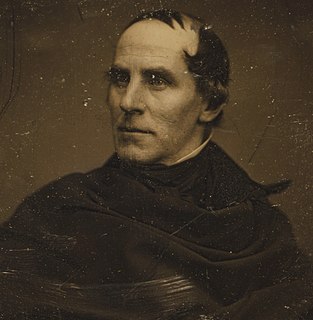 W
WThe Voyage of Life is a series of four paintings created by Thomas Cole in 1842, representing an allegory of the four stages of human life. The paintings, Childhood, Youth, Manhood, and Old Age, depict a voyager who travels in a boat on a river through the mid-19th-century American wilderness. In each painting the voyager rides the boat on the River of Life accompanied by a guardian angel. The landscape, each reflecting one of the four seasons of the year, plays a major role in conveying the story. With each installment the boat's direction of travel is reversed from the previous picture. In childhood, the infant glides from a dark cave into a rich, green landscape. As a youth, the boy takes control of the boat and aims for a shining castle in the sky. In manhood, the adult relies on prayer and religious faith to sustain him through rough waters and a threatening landscape. Finally, the man becomes old and the angel guides him to heaven across the waters of eternity.
 W
WThe Windsor Beauties are a famous collection of paintings by Sir Peter Lely, painted in the early to mid-1660s, that depict ladies of the court of King Charles II, some of whom were his mistresses. The name stems from the original location of the collection, which was housed at Windsor Castle. They can now be seen at Hampton Court Palace.